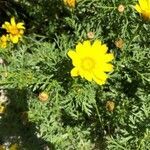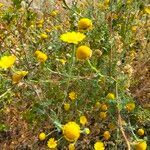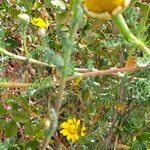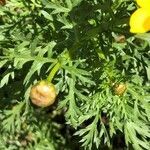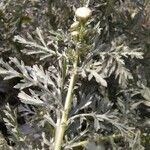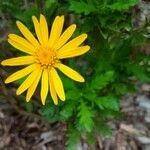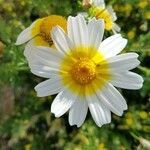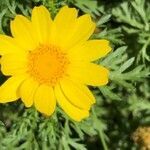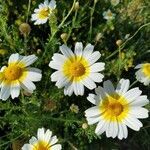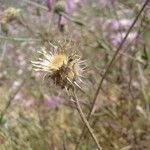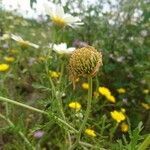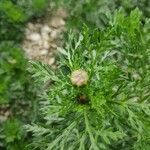Herbs, annual, glabrous or almost so; stems erect, 70 cm tall, unbranched or few branched above middle. Basal leaves withered by anthesis; lower and middle stem leaves sessile; leaf blade narrowly elliptic or elliptic-lanceolate in outline, 8-10 × 3-4 cm, 1 or 2(or 3)-pinnatisect or pinnatifid, primary segments 2-4-paired, ultimate lobes ovate or linear; upper stem leaves gradually smaller. Capitula terminal, solitary or few, not forming conspicuous panicle; peduncle 15-20 cm. Involucres cup-shaped, 1.5-3 cm in diam.; phyllaries in 4 rows, inner ca. 1 cm, apex widened, scarious. Ray achenes narrowly 3-winged. Disk achenes 1-or 2-ribbed. Fl. and fr. Sep. 2n = 18*
An annual herb eaten at the seedling stage when it is not more than 20 cm high. It has many branches and grows 2 m tall. Leaves are succulent with a light silvery tinge and broadly serrated edges. There are a range of variations in leaf size and shape. They can be toothed or deeply indented. The flowers are golden. They are produced in large numbers. There are several cultivated varieties. There have been some attempts to preserve the name Chrysanthemum coronarium
Annual, branched herb, up to 1 m high. Leaves alternate, sessile, auriculate at base, pinnate or bipinnate, glabrous. Capitula radiate, pedunculate, solitary at ends of branches; involucre campanulate; bracts imbricate, with brownish, scarious margins. Ray florets yellow or yellowish white. Disc florets yellow. Flowering time Aug.-Dec. Pappus absent. Cypselae dimorphic, those of ray florets 3-angled, angles winged, those of disc florets compressed and ribbed.
Leaf blades oblong to obovate, mostly 30–55+ × 15–30+ mm, mostly 2–3-pinnately lobed, ultimate margins dentate. Ray corollas pale yellow, sometimes white-tipped, laminae oblong to linear, 15–25 mm. Ray cypselae triquetrous, 2.5–3 mm, angles ± winged, faces obscurely nerved or ribbed; disc cypselae ± prismatic, ± compressed, 2.5–3 mm, obscurely ribbed, sometimes with adaxial (rarely the abaxial) rib ± winged. 2n = 18.
